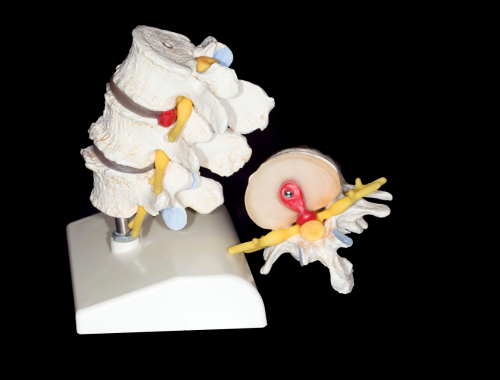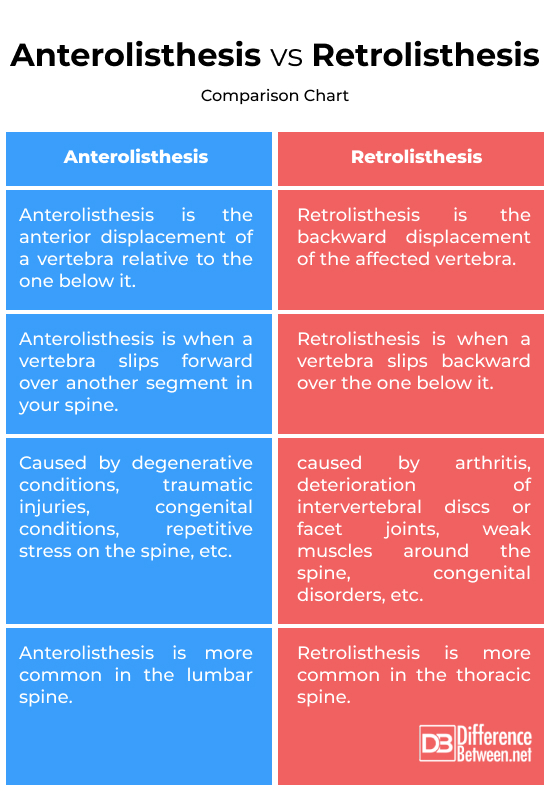Difference Between Anterolisthesis and Retrolisthesis Radiology
Anterolisthesis and Retrolisthesis are spine-related conditions that impact the lower vertebrae, which can be a painful proposition. Pain in the neck, low back, and mid back is a common problem in adults. One such condition that involves spine instability is Spondylolisthesis, which occurs when a vertebra slips out of position. This can occur in two ways: Anterolisthesis and Retrolisthesis. Anterolisthesis refers to the forward slippage of a vertebra and Retrolisthesis is a forward slippage. Let’s break down the key differences between Anterolisthesis and Retrolisthesis.

What is Anterolisthesis?
Anterolisthesis is a misalignment of bones in the spine that mainly affects the lower back region. It is a slippage of the spinal vertebrae where a vertebra slips forward over another vertebra in the spine, usually the one below it. The commonly affected region is the lumbar spine which can cause pain in the low-back and legs. Aging is one of the primary factors that can cause Anterolisthesis, but there can be other factors involved, such as congenital disorders, traumatic injuries, degenerative conditions, etc.

What is Retrolisthesis?
Retrolisthesis is the backward displacement of one vertebra over another in the spine. It is a rare joint dysfunction that causes a vertebra in your spine to slip backward on another vertebral segment. So, the affected vertebra shifts backward out of alignment with the rest of the spine to a degree less than a dislocation. This usually occurs when the space between the vertebrae reduces or the discs between them shrinks. Treatment is done to reduce the inflammation and pain.
Key Differences between Anterolisthesis and Retrolisthesis
Alignment of the Vertebrae
– Anterolisthesis is a misalignment of the spinal vertebrae where a spinal vertebra has slipped forward over another segment of the spine. This is the anterior displacement of a vertebra relative to the one below it. Retrolisthesis is backward displacement of the affected vertebra where a vertebra slips backward on the vertebra below. This is a less common condition than Anterolisthesis and is often seen in the thoracic spine.
Possible Causes
– Anterolisthesis can be caused by several factors, often as a result of a trauma or injury which results in vertebral fracture or severely impacts the spinal column. Other factors include degenerative conditions, traumatic injuries, congenital conditions, repetitive stress on the spine, and so on. Retrolisthesis can be caused by arthritis, degenerative spinal conditions, deterioration of intervertebral discs or facet joints, weak muscles around the spine, congenital disorders, etc.
Symptoms
– While both are different conditions that involve the spine, they may cause similar symptoms, such as stiffness in the low-back, cramping in the leg muscles, nerve compression, muscle weakness, tingling sensation, numbness, and more. The specific symptoms may vary depending on the severity of the slippage and the impacted spinal region.
Anterolisthesis vs. Retrolisthesis: Comparison Chart

Summary
In a nutshell, both are spine-related conditions that cause pain in the lower back or legs, muscle weakness, nerve compression, and more. The main difference lies in the direction of the slippage; Anterolisthesis is when a spinal vertebra has slipped forward over another segment in the spine, while Retrolisthesis is when a vertebra slips backward over the one below it. Besides that, both conditions can cause similar symptoms and require almost similar treatment approaches.
FAQs
What is the difference between Retrolisthesis and Anterolisthesis?
Retrolisthesis is when a vertebra slips backward over the one below it, while Anterolisthesis is when a vertebral segment slips forward over another segment in your spine.
What is the difference between Retrolisthesis and Spondylolisthesis?
Spondylolisthesis is a general term for any spinal condition where a vertebra slips forward or, much less commonly, backward on the vertebra below. Retrolisthesis is the latter condition where a vertebra slips backward over the one below it.
What are the grades of Anterolisthesis in radiology?
The grades are determined by the percentage of slippage on a scale of I to IV. Grade I reflects a slippage of 5% to 25%; grade II 26% to 50%; grade III 51% to 75%; and grade IV indicates more than 50% of slippage.
What is the difference between Grade 1 and Grade 2 Retrolisthesis?
Grade 1 indicates that the vertebra has slipped backward by up to 25%, while Grade 2 indicates a slippage of 26% to 50%.
How do you treat Anterolisthesis and Retrolisthesis?
Treatment of Anterolisthesis and Retrolisthesis may include adequate bed rest, physical therapy, exercise, and in many cases, surgery to stabilize the spine.
Can you correct Retrolisthesis?
In some cases, Retrolisthesis can be corrected with conservative treatments like physical therapy, lifestyle changes, and core strengthening exercises. In more severe cases, surgery may be required.
What are the criteria for Anterolisthesis?
Possible symptoms may include pain in the lower back or legs, numbness in the legs, sensory changes in the legs, and at least 25% of slippage.
Is Anterolisthesis degenerative?
Anterolisthesis is an abnormal alignment of bones, which may lead to instability and forward slippage of a vertebra. It is often seen in the older population because of degenerative changes.
What is Anterolisthesis of L5?
Anterolisthesis often occurs at the L5-S1 level, which indicates that the fifth lumbar vertebra is slipped forward in relation to the sacrum (S1).
- Difference Between Caucus and Primary - June 18, 2024
- Difference Between PPO and POS - May 30, 2024
- Difference Between RFID and NFC - May 28, 2024
Search DifferenceBetween.net :
Leave a Response
References :
[0]Bartleson, J. D. and H. Gordon Deen. Spine Disorders: Medical and Surgical Management. Cambridge, United Kingdom: Cambridge University Press, 2009. Print
[1]Frontera, Walter R. and Julie K. Silver. Essentials of Physical Medicine and Rehabilitation: Musculoskeletal Disorders, Pain, and Rehabilitation. Pennsylvania, United States: Elsevier, 2019. Print
[2]Wyatt, Lawrence H. Handbook of Clinical Chiropractic Care. Massachusetts, United States: Jones & Bartlett Publishers, 2005. Print
[3]Image credit: https://www.canva.com/photos/MAExUxzUt0s-backbone-spinal-vertebra-model/
[4]Image credit: https://www.canva.com/photos/MAEv6DFnfTo-doctor-neurologist-holds-a-mock-spine-with-intervertebral-hernia-the-doctor-makes-the-paravertebral-block-into-a-hernia-of-the-spine-the-concept-of-treating-a-hernia-of-the-back-with-the-injection-of-chondroprotectors-and-anti-inflammatory-drugs/
